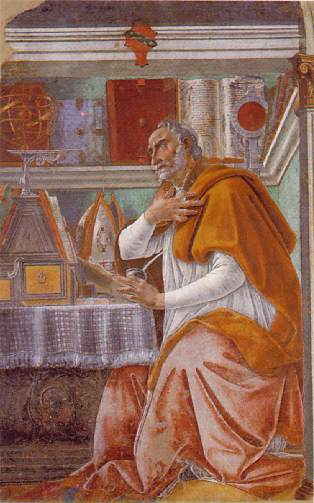Here we go! Below you'll find the first guest post written by Michelle of Quantum Theology, in which she provides a great deal of information about Augustinian friars, about whom I previously knew next to nothing:
Before all else, I want to say thank you to Robin for this invitation to visit her blog, and that I'm very excited about her guesting at my space! Robin and I met (epistolary if not literally) several years ago, through the RevGalBlogPals webring we both belong to. We share an interest in Ignatian spirituality — Robin is a spiritual director in the Ignatian tradition and we have have both made St. Ignatius' Spritual Exercises, Robin in everyday life with an extraordinarily gifted and experienced Jesuit director, while I spent 30-days wrapped in silence at the Jesuit retreat house in Gloucester, Massachusetts.
Before all else, I want to say thank you to Robin for this invitation to visit her blog, and that I'm very excited about her guesting at my space! Robin and I met (epistolary if not literally) several years ago, through the RevGalBlogPals webring we both belong to. We share an interest in Ignatian spirituality — Robin is a spiritual director in the Ignatian tradition and we have have both made St. Ignatius' Spritual Exercises, Robin in everyday life with an extraordinarily gifted and experienced Jesuit director, while I spent 30-days wrapped in silence at the Jesuit retreat house in Gloucester, Massachusetts.
Recently, both of us have been reading Into the Silent Land, a small, wonderful book about deepening a practice of Christian contemplation. I'm drawn to the rich mix of the mystic, the academic and the pragmatic that the author, Martin Laird, OSA, stirs up for us.
Speaking of the author, the first question Robin asked me is about the author. Martin Laird is an Augustinian friar, and since I regularly join the Augustinian community at my parish to pray the Litugy of the Hours (aka the Divine Office), Robin wonders: what makes an Augustinian?
The OSA stands for Ordo Sancti Augustini (Order of Saint Augustine in Latin; this is the Roman Catholic communion after all). And while the order traces its roots to St. Augustine of Hippo (354 - 430), the foundations of the modern order date to the 13th century. The Augustinians are one of the major orders in the Church, in company with the Franciscans, Benedictines, Dominicans, and of, course, the Jesuits, founded by St. Ignatius.
The Augustinian friars are monastics who live out the evangelical counsels — poverty, chastity and obedience — but are not enclosed in their monasteries like the Trappists that Thomas Merton belonged to or the Carthusians of Into Great Silence, but venture forth to minister. Villanova University, just down the road from me, was founded by the Augustinians, and education is a major apostolate for them. (And for the science geeks among us, Gregor Mendel, the father of modern genetics, was an Augustinian monk.)
Perhaps more relevant to venturing into The Silent Land, the Augustinians value their life in community, in balance with a serious attention to the interior life. The rule requires that there be places that the monks can go and give their full undisturbed attention to prayer. They seek explicitly to encounter God in Holy Scripture. For me, watching this balance between community life and the interior life and prayer in common and individual prayer play out has been formative in my own spiritual life. And spending all that time with people who are seeking God in His Word is in all likelihood what drew me to Ignatian spirituality.
In the mornings, the move from bustle and banter to a full and focussed attention on prayer never ceases to amaze me. The praying of the Hours may be required by the Rule of the order, but it is an office of love for these men. I've been praying the Hours with the Augustinians for 20 years, and through that, they have had the forming of me. When I made the Exercises, I had a very hard time laying down the Office, and even as the contemplations of the Passion grew more intense, clung to it. When I washed up in my director's office at the end of the 3rd week it became clear that Hours were not something I said, even in the midst of the taut exhaustion of those final meditations, but prayed from the depths of my heart. The psalms are in my bones, put there by two generations of Augustinians.
I'm not an Augustinian, so I can't really say what it is like to be one, but from where I sit, I might say that they are men who have a serious interior life, are grounded in scripture and who live out a life of service, drinking from those two fonts. So I'm not surprised to find an Augustinian writing a book about the contemplative Christian life!
(Image: St. Augustine as painted by Botticelli in 1480, here.)
(Image: St. Augustine as painted by Botticelli in 1480, here.)

Beautiful. It is amazing to see how ordered is the design, even in things like which order one is introduced to, and travels with.
ReplyDeleteIt makes sense to me that it would be Augustinians for you, and who have brought you into their world of balance and depth. The academic and spiritual natures are strong, each fed by the other.
I think that is something I've often felt is the real stamp of Augustine, from his own writings.
I found my way through the Cistercians, in Conyers, GA. They have helped me find a way to simply sit. In the silence. And be. With Christ, and with the Church. And to do so in a way that seems sustainable.
It is nothing short of a miracle.